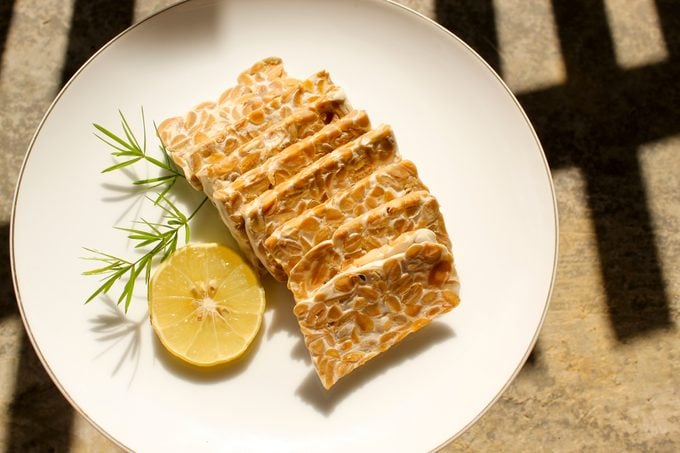Here’s Why Nutritionists Love Tempeh (Plus How to Eat It)
Updated: Jun. 28, 2021
Tempeh is a high-protein meat alternative made from fermented soy and packed with nutrients and prebiotics. Learn about its nutrition, health benefits, and more.
Our editors and experts handpick every product we feature. We may earn a commission from your purchases.
On This Page
What is tempeh exactly?
For years, tempeh has lived in tofu’s shadow.
Not anymore. By 2026, global tempeh sales are projected to reach $5.8 billion, a 61 percent jump over 2018 estimates, according to the research firm Persistence Market Research.
Why is tempeh’s popularity suddenly on the rise?
“Whether you’re trying to eat more plant-based meals, eat a bit ‘greener,’ or reduce your meat intake, tempeh is a great plant-based protein alternative to tofu, beans, lentils, peas, and nuts,” says Sharon Palmer, a registered dietitian nutritionist in Ojai, California, and author of California Vegan. “Plus, it’s super easy to use, no cooking required. Just chop it, and it’s ready to go.”
Tempeh is essentially a fermented soybean cake. It’s made via a multistep process that starts with soaking, boiling, and draining whole soybeans.
The beans are then inoculated with mold spores (most often from the species Rhizopus oligosporus) and fermented. The result is a firm, plant-based protein alternative with a mild, nutty, mushroom-like flavor.
Even though tempeh is traditionally made from soybeans, there are a few other spins on it.
“Many legumes, such as lentils, black beans, and chickpeas, can ferment into tempeh,” says Michele Redmond, a registered dietitian nutritionist, chef, and flavor specialist at The Taste Workshop, which teaches food culture and how to taste and cook food. “It can also be made with grains like millet, oats, buckwheat, and brown rice or seeds like flaxseed or sunflower seeds.”
Origins of tempeh
Tempeh originated in Indonesia in the 1600s, where it remained a well-kept secret for hundreds of years.
Around the beginning of the 20th century, it began to move throughout Asia, first popping up in Japan and soon after in India.
Eventually, it migrated westward, arriving in the United States in the late 1950s.
Where to buy tempeh
It may be less well-known than its soy sister tofu, but tempeh is still widely available. And it’s getting easier and easier to find this plant-based protein, no matter where you live.
You can buy tempeh in supermarkets, big box stores, fast food chains, and sit-down restaurants.
Tempeh nutrition
Nutritionists are big tempeh fans—and with good reason.
“This versatile plant protein is extremely nutrient rich,” says Palmer. “So it’s ideal for healthy, delicious, sustainable plant-based meals.”
Here are the nutritional highlights for one cup (166 grams) of cooked tempeh:
Calories: 319
Fat: 18 g (23 percent daily recommended value, or DV)
Sodium: 15 mg (1 percent DV)
Carbohydrate: 13 g (5 percent DV)
Protein: 34 g (68 percent DV)

Tempeh benefits
Complete protein
Just like other soy foods (such as tofu, soy milk, and edamame), tempeh provides complete protein. That’s rare for a plant food.
Here’s why: Even though beans, grains, nuts, and seeds contain protein, their protein is almost always incomplete.
That means they lack one or more of the nine essential amino acids our bodies need to build their own protein supply.
While eating lots of different kinds of plants can supply all the essential amino acids your body needs, complete proteins—which you can get from meat, poultry, seafood, eggs, and dairy—deliver the whole package in one convenient shot.
This is good news for vegetarians and vegans, who often miss out on complete proteins because they don’t eat animal products. Soy makes for a solid stand-in.
(Tempeh vs. tofu: here’s how they compare.)
A heart-friendly meat alternative
Both tempeh and beef are loaded with complete protein, but tempeh wins out for heart health. Why?
“Tempeh is very low in saturated fat and instead contains heart-healthy unsaturated fats like polyunsaturated and monounsaturated fat,” says Deborah Murphy, a nutritionist in Chicago.
It also happens to be cholesterol free, like all plant-based products. (Cholesterol is made in the liver so it can be found in animal-sourced foods, but not those derived from plants.)
The beauty of tempeh is that it also provides fiber and soy isoflavones, which do double duty to protect your ticker by naturally lowering blood cholesterol, says Murphy.
Gut-friendly prebiotics
“Although tempeh is a fermented food, it’s cooked before we eat it, so many of its probiotics are lost,” says Murphy. “However, tempeh is still a good source of prebiotics, which feed the beneficial bacteria in your gut.”
Plus, fermentation isn’t only about probiotics. The fermentation process also increases the availability of certain nutrients in tempeh, such as iron, riboflavin, niacin, biotin, folate, and vitamin B6.
Easier weight management
“Tempeh’s protein and fiber deliver a one-two punch, helping you feel full longer after eating it,” says Murphy.
Fiber is so helpful for weight loss that a 2019 The Journal of Nutrition study of 345 adults found that fiber intake was the No. 1 predictor of a person’s weight-loss success. And not only because it helps you eat less. According to the study’s authors, fiber also has the ability to block the digestion of small bits of protein and fat, whisking them out of the body before you can absorb their calories.
Risks or side effects
What about myths that soy is bad for you? Nutritionists aren’t too concerned.
Fact: soy doesn’t cause breast enlargement in men. Fact: soy doesn’t raise your breast cancer risk. It’s actually linked to a lower risk of breast cancer.
“It’s completely safe and healthy to eat up to two to three servings of soy products, such as tempeh, daily,” says Palmer.
Of course, if you’re allergic or sensitive to soy, you’ll want to avoid it. Because tempeh can sometimes contain gluten from certain grains, it’s also a no-go for anyone with gluten sensitivity or celiac disease, adds Palmer.
How to add tempeh to your diet
One of the really nice things about tempeh is its mild flavor.
“Use this to your advantage,” says Redmond. “Let tempeh soak up flavors commonly paired with meat dishes, such as marinades, marinara, barbecue sauce, and curries.”
Tempeh also gets high marks for versatility. Its firm, meaty texture lends itself to baking, steaming, grilling, roasting, and sautéing.
“Tempeh holds its form well when sliced or cubed,” says Murphy. “But you can also crumble it into smaller pieces and cook it up as an alternative to ground meat in dishes like chili or tacos.”
If you’re intrigued with tempeh but aren’t quite sure where to begin, Redmond recommends dipping your toes in to test the water. Instead of making tempeh the centerpiece of your meal, use it as ingredient in a larger recipe, or try it as a side dish.
Looking for more tempeh inspiration? Try these nutritionist-approved ideas and learn more about how to cook tempeh:
Breakfast
Murphy loves tossing cubed tempeh into a vegetarian hash.
Redmond suggests satisfying a bacon craving with bacon-flavored tempeh.
It’s filled with smoky bacon flavor, minus the meat.
Lunch
“For an easy way to add some plant-based protein to your lunch salad, toss in some sautéed tempeh,” suggests Murphy.
If a sandwich is more your speed, “slather tempeh with your favorite barbecue sauce, broil it until the edges are crunchy, and tuck it in a lettuce wrap,” says Redmond.
Dinner
“You can use tempeh the same way you might use tofu or other meat alternatives: in casseroles, stir-fries, and more,” says Murphy.
Its meaty mouthfeel and chewy texture also make it a wonderful alternative to ground meat in chili or meatloaf, adds Redmond.
For even more easy, delicious ways to enjoy tempeh, check out these recipes:


















